Hay is an integral part of horse feeding. Apart from grass, equines consume hay on a daily basis. Green pastures are not available all year round. Feeding horses with hay ensures your animals get enough food per day. Proper feeding affects the digestive system and overall well-being. Thus, every horse owner must know how to feed horses and distinguish common types of hay.
Fruits and vegetables are nutrient-rich products full of vitamins. In fact, the same goes for hay. Providing different types of grasses and legumes helps to maintain proper horse health care. Knowing the benefits of common horse feed may help you take full advantage of it. Let’s get the hang of feeding hay to equines.
How Much Hay Does a Horse Eat?
The Humane Society of the United States claims that an average 1000-pound horse has to eat 1-2% of its body weight per day. An equine must have unlimited access to pasture. If grass supply is limited, add hay to the meal plan.
A more precise estimate can be done depending on the horse’s body weight, age, and state of health. The University of Kentucky made research regarding the amount of forage needed for various classes of horses. An equine for high levels of performance, as well as a pregnant mare, should consume forage that is 1-2% of their body weight. For a weanling, the range is 0.5-1.8%. For a yearling, it’s 1-2.5%.
For instance, a performance gelding weighs 1,150 pounds. Taking into account the information mentioned above, this horse should consume 1-2% of its body weight in forage per day. That’s around 11.5 to 23 pounds of food. This will allow the animal to keep a proper weight and stay full. In case forage is the only type of feeding for horses, the amount of it should reach the upper limit of the range (23 pounds).

How Much Hay to Feed a Horse Per Day?
An average adult horse should eat 10-20 pounds of hay per day. It’s equivalent to a square bale of 40-60 pounds used for a few days.
The numbers are approximate, as a precise amount of forage depends on a range of factors. This includes the horse’s workload, metabolism, season, nutrition plan, etc. Growing horses need more food. While old equines that spend more time at the stables eat less.
Ponies tend to have a slower metabolism in comparison with horses. Thus, they need less forage to be fed. Up to 3-5 pounds of hay will be enough for a pony per day. Alternatively, draft horses, who work actively, are likely to consume up to 30 pounds of hay per day.

How Much Hay to Feed a Horse in Winter
The horse’s diet may vary in winter. When the days are getting colder, horse owners must ensure their animals get enough nutrients. The high-quality forage fed to horses has to provide enough nutrient content. This will help to keep equines comfy and healthy. Plan ahead the horse’s diet in winter to maintain proper horse care.
The equine’s way of living may be different in winter. Less workload, rare turning out could lead to decreasing the activity level. Besides, low temperature, frequent wind and snow make the animal need more energy to stay warm.
In winter, there could be limited access to pasture with grass. In this case, hay is an essential part of the equine’s diet. It’s a crucial source of protein and energy. Your horse may require more hay, especially if you’re living in extremely cold conditions. Horse owners must watch their animals don’t lose weight in the cold season.
Grain and concentrates are great supplements to the meal plan in winter. They will help the equine to keep a healthy body condition. For those animals, who spend much time outside in winter, consider round bales and mini horse hay feeders. Such a hay bale weighs about 800 to 1200 pounds. It’s enough to feed a horse for 3-4 days. Round bales are great to provide constant access to feed while reducing waste inside the barn.

Increase the amount of hay to 30-50% in winter. This will help to maintain proper feeding. A decrease of one degree Fahrenheit below zero leads to an increase in energy requirements of 1% for body temperature control. Hay is a great option to meet the nutrient requirements in winter. It contains a solid amount of fiber, more than grain has. When equines are consuming forage, a great amount of heat is produced to regulate the body temperature.
If a horse eats 20 pounds of hay daily, feed it with up to 30 pounds of hay in winter. It’s vital to keep a proper energy balance. Feed your horse at least three times a day. Enough feed promotes energy produces enough heat to keep horses warm and withstand cold weather.
For extra heating, consider tacking an equine with a horse blanket. Different types of gear are suitable for turning out and staying in the stable.
Before feeding hay to horses, check the bales for mold and dust. Mold could cause colic while dust could lead to respiratory issues. Besides, not all hay has the same quality. Get your hay tested for nutrient content. It will help to find whether it meets the horse’s needs.
Get help from an experienced equine nutritionist to make a meal plan. They will examine the horse’s state of health and adjust nutrition needs.
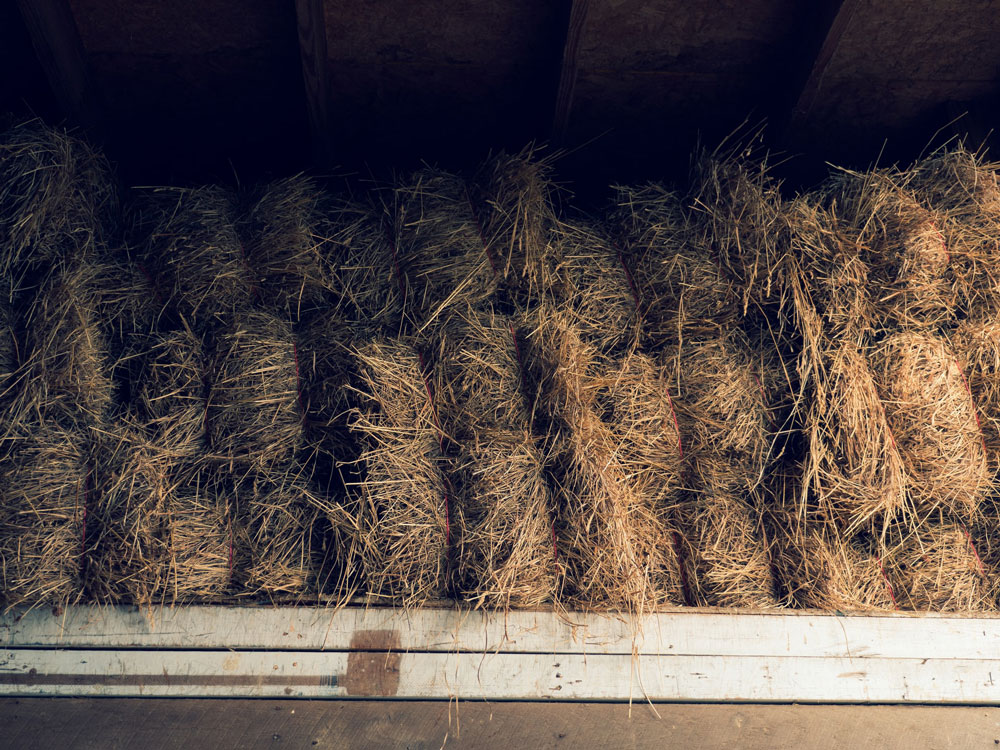
Which Type of Hay is Best for Horses?
The most common types of hay are grass and legume hay. Each of them features its nutritional value. Look for a good-quality product that is best for your horse. Grass hay vs legume hay – check this guide to make your choice.
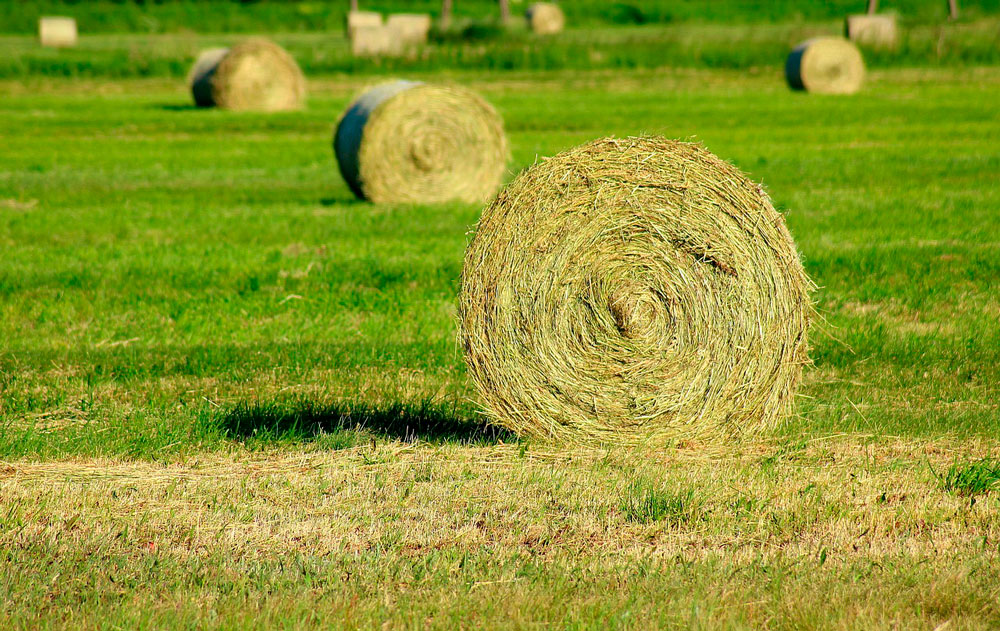
Grass Hay
Grass hays have a high level of fiber that is essential for a horse’s diet. However, this type provides less energy and protein. This means a horse needs more grass hay to get full. It’s a good point though. Constant grazing could distract an equine from boredom. Especially, if it spends most of its time in the stall.
Feeding with grass hay is suitable for equines who work light as well as retired horses. That’s a great product to add roughage to the nutrition plan with enough calories. The hay promotes proper digesting reflecting the natural grazing on the pasture. So equines can eat slowly throughout the day.
A growing horse and hard-working equines require much energy. Grass hay feeding may not fulfill all the nutrient requirements needed. You should look for extra supplements to gain enough energy.
Common quality grass hays include orchardgrass, Kentucky bluegrass, and timothy.

Orchardgrass
Orchardgrass is a bunchgrass that grows in clumps. The plant has light green leaves folded at the base. It grows up to 40 inches tall. Orchardgrass is a common dietary intake of horses. Animals consume it with hay or on pasture.
This type of grass is friendly to well-drained soil. Wet soil is not the best option to grow. As animals may dig up the plants while grazing. Seed the orchardgrass closely to each other to avoid that.
The seasonal production goes from March to November. July and August are considered as periods with limited growth. High-fertility soil is recommended with a pH level of 5.5 to 7.0.

Kentucky Bluegrass
Kentucky bluegrass is one of the most delicious grasses for many horses. It forms a tight sod and is friendly to close grazing. It’s a low-growing plant. The bluegrass is 12 to 20 inches in height. The leaves are narrow and the tips are pointed.
The plant requires high-fertility soil with solid drainage. The pH level must reach the range of 5.8 to 6.5. It may grow in a low-fertility condition though.
High temperatures and droughts are not friendly to Kentucky bluegrass. The growing process considerably slows down in the hot season.
The seasonal production is expected from April to October. July and August feature limited growth. Kentucky bluegrass produces less forage than Orchardgrass.

Timothy
Timothy hay is a common form of usage as the plant isn’t good for constant grazing. The herb is a tall bunchgrass. The seed heads are dense and spike-like. The leaves are light green and flat.
The seasonal production goes from April to November. The summer season features lower growth. The plant is not good for close grazing.
High temperatures and wet soil are not friendly to timothy. Droughts are also unacceptable for it. The plant isn’t durable. You’re likely to replant it every year or two.
The plant is used to feed horses with timothy hay. Mind that its production is less than orchardgrass makes.
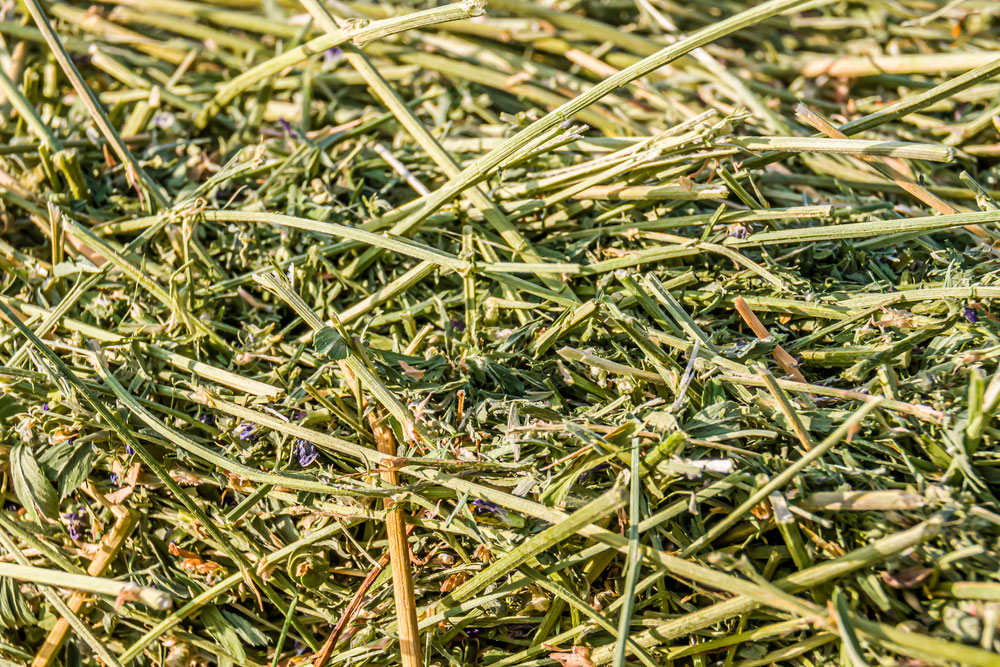
Legume Hay
Legume hays have a high level of protein and calcium. They provide more energy and contain lots of essential nutrients. Thus, equines get full with less amount of legume hay than of grass hay.
This type of hay is higher in protein and vitamin A. It may encourage an animal to drink more. This affects better hydration, which is a plus.
Legume hay feed is beneficial for lactating mares, growing foals, and working horses. Performance equines enjoy legume hay most. As it provides enough energy while being satisfying.
Such type of hay is not good for easy-keeping horses. The same goes for retired horses. As they prone to put on weight quickly. Besides, legume hays prone to accumulating dust and mold. Make sure the feed is safe before feeding horses.
Alfalfa, red clover, and birdsfoot trefoil are the most common legume hay types.

Alfalfa
Alfalfa is the most popular type of legume hay. The plant is more nutrient-dense than other grasses. It’s full of calcium and protein that is advantageous for underweight equines.
Horses with muscle issues are also recommended to consume alfalfa hay. As well as equines with equine metabolic syndrome. The herb is ideal for growing horses, lactating mares, performance horses, and thin equines.
Alfalfa hay is considered lower-sugar hay. This is beneficial for animals sensitive to sugars and starches. You can add alfalfa to the meal plan for horses with insulin resistance. A solid foundation of forage is crucial for building a diet for such horses. Oat hay, barley, and corn can be replaced with alfalfa hay.
Beware that this plant attracts blister beetles. And the haying equipment may not get rid of all of them. Blister beetles usually occur in June. These insects are highly dangerous to horses. A blister beetle contains cantharidin – the toxin that may kill a horse if consumed in a large amount.
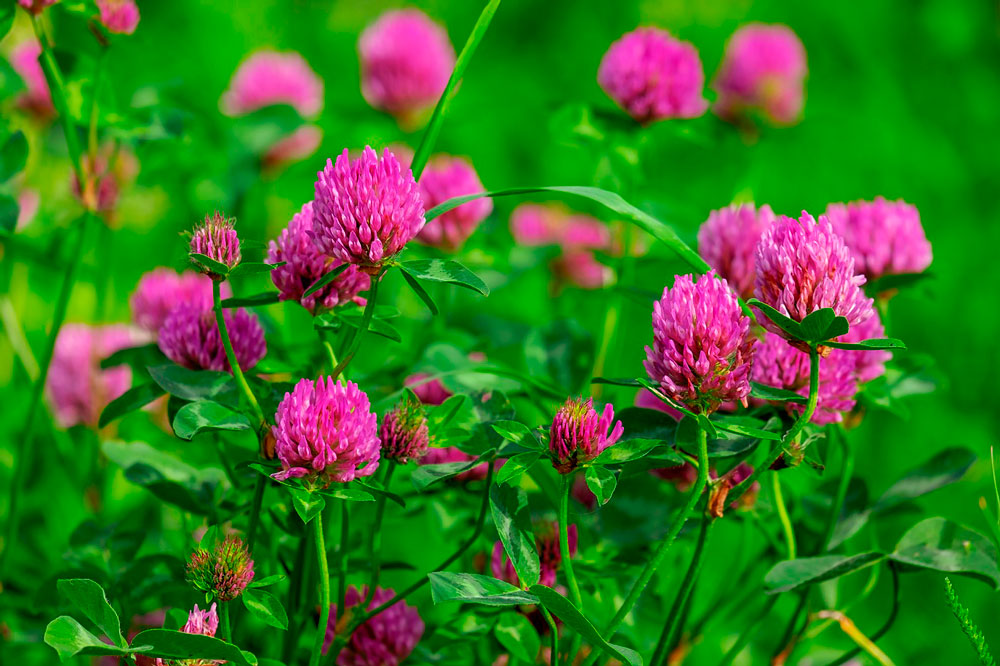
Red Clover
Red clover hay is another popular horse feed. The plant is tall. It can grow up to 30 inches in height. The leafy stems are hairy. The flowers are pink that are folded into head shapes.
The seasonal production goes from April to October. Red clover can withstand droughts. It should be reseeded every 2-3 years. The herb is friendly to close grazing. It’s regularly planted with other plants like orchardgrass and timothy.
The plant may cause slobbering in equines. Keep it in mind as it could lead to dehydration in severe cases.

Birdsfoot Trefoil
If growing alfalfa is challenging, you may consider planting birdsfoot trefoil. The plant is also a great source of high-quality protein for equines.
The herb is friendly to poor-fertility soil. It also can withstand poorly drained soils. The growing process isn’t slowed down in late summer. That is beneficial as most legumes and grasses struggle in the hot season. The plant is usually seeded with other grasses like Kentucky bluegrass, orchardgrass, and timothy. It can reseed itself, which is a plus.
Check the plant for mold before feeding. It’s a common issue that may lead to slobbering.
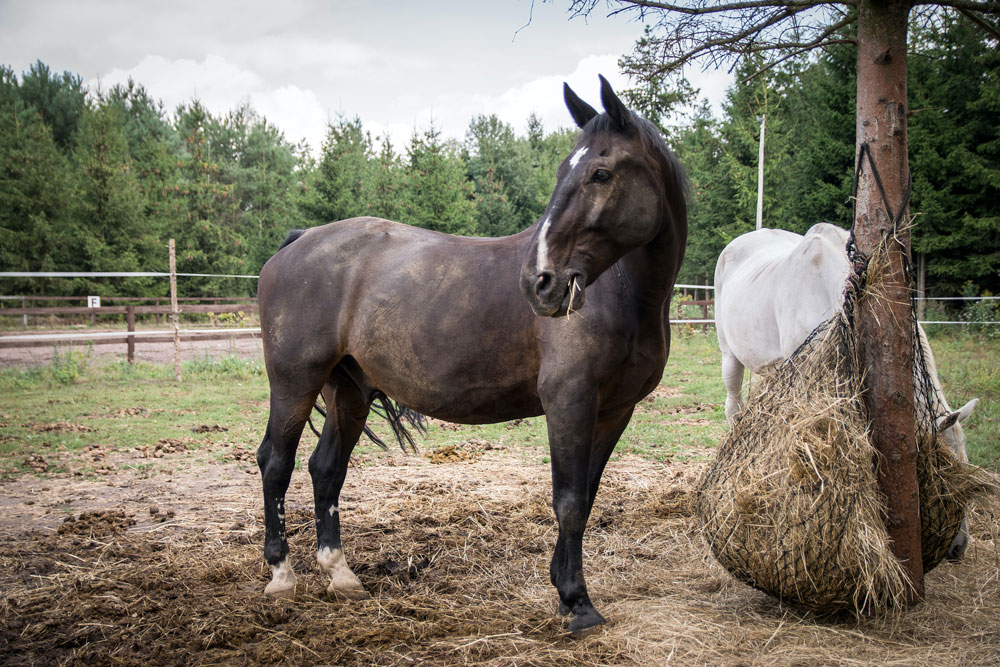
Factors to Consider Best Hay for Your Horse
- Check when hay was harvested. Easy-keeping horses can be fed with mid- or late-maturity good-quality hay. As it provides fewer nutrients, hence, fewer calories to process. Early-maturity hay is suitable for hard-working horses and growing foals that will be satisfied quickly. Its nutritional value is excellent to provide enough energy. Mind that a bored equine craving more forage may start chewing such objects as stalls, fences, and trees. Make sure you provide enough food for long-term consumption.
- Hay quality is important. High-quality hay for horses has little mold and dust. So you rest assured your animals will get feed safe to their health.
- Check the product’s color and odor. Most types of hay for horses come with light green color. You’ll notice a fresh odor that is pleasant to smell.
- Visit your vet. Contact your vet to prepare an individual meal plan. A qualified professional will advise you on what type of hay to choose and how to mix them duly. The lion’s share of a horse’s diet is roughage. You should know proper hay fed to horses.

Horse Hay Quality Explained
Feeding horses with proper food affects the overall well-being. Consider good products to prolong the equine’s longevity and happy aging. The most common hay options are grass hay and legume hay. Both of them are quite nutritious and contain useful elements.
Check the horse’s condition to build a proper nutrition plan. The amount of hay needed to feed a horse depends on a range of factors. These are age, body weight, usage, season, and others. That’s why a professional vet will help you evaluate how much hay your horse needs.
With proper feeding comes solid watering. Provide your equine with constant access to fresh water all year round. An automatic waterer with a heater may come in handy in winter.
